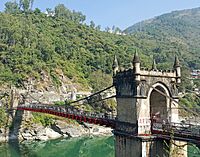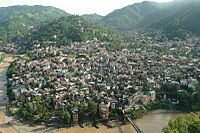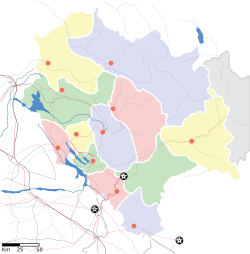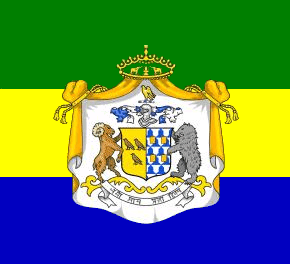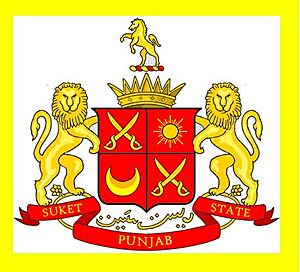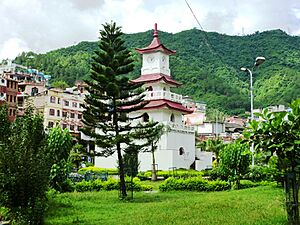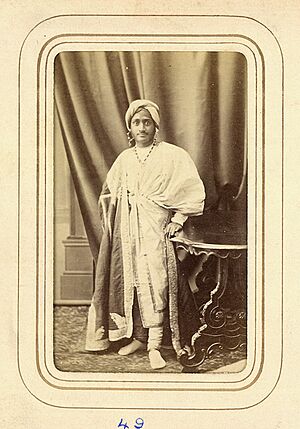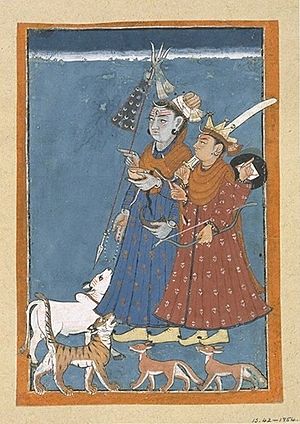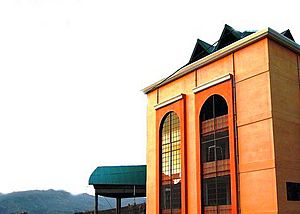Mandi, Himachal Pradesh facts for kids
Quick facts for kids
Mandi
Choti Kashi
|
|
|---|---|
|
City
|
|
|
From top, left to right: Victoria Bridge, Mandi town, Panchvaktra Temple & Prashar lake
|
|
| Nickname(s):
Choti Kashi, Varanasi of Hills
|
|
| Country | |
| State | |
| District | Mandi |
| Municipality | Mandi |
| Established | 1527 |
| Talukas | Mandi Sadar |
| Government | |
| • Type | Municipal Corporation of Mandi |
| Elevation | 760 m (2,490 ft) |
| Population | |
| • Total | 26,422 |
| • Rank | 6 in HP |
| Languages | |
| • Official | Hindi |
| • Regional | Mandeali |
| Ethnicity | |
| • Ethnic groups | Mandyali |
| Time zone | UTC+5:30 (IST) |
| PIN |
175 001
|
| Telephone code | 91-01905 |
| Vehicle registration | HP-28, HP- 29, HP-30, HP-31, HP-32, HP-33, HP-33AA, HP-65, HP-76, HP-82, HP-86, HP-87, HP-87 AA |
| Nearest city | Sunder Nagar |
| Sex ratio | 1000/1013 ♂/♀ (2nd in HP) |
| Literacy | 83.5% |
| Lok Sabha constituency | Mandi (Lok Sabha Constituency) |
| Planning agency | Town and Country Planning Department, Himachal Pradesh, India |
| Civic agency | Municipal Corporation of Mandi |
| Present King | HH Raja Ashokpal Sen |
| Climate | Cwa |
| Precipitation | 1,380 millimetres (54 in) |
| Avg. annual temperature | 24 °C (75 °F) |
| Avg. summer temperature | 35 °C (95 °F) |
| Avg. winter temperature | 17 °C (63 °F) |
| † The Mandi Planning area also includes some portions of Mandi District. | |
Mandi is a big city and a municipal corporation in Mandi District in the Indian state of Himachal Pradesh. It's located about 145 kilometers (90 miles) north of Shimla, the state capital. Mandi is in the north-west Himalayas at an average height of 880 meters (2,887 feet).
The city is connected to Pathankot by National Highway 20 and to Manali and Chandigarh by National Highway 21. Mandi is about 185 kilometers (115 miles) from Chandigarh and 441 kilometers (274 miles) from New Delhi, India's capital. In 2011, Mandi city had a population of 26,422 people. Mandi district is the 4th largest economy in Himachal Pradesh. It also has a high sex ratio, with 1013 females for every 1000 males.
Mandi is the main city for Mandi District. It is also a central hub for nearby districts like Kullu, Bilaspur, and Hamirpur. People often call Mandi the "Varanasi of Hills" or "Choti Kashi" because it has many temples. It's also a starting point for the famous Prashar lake trek. Trekkers usually go to Bagi village first, which is the base for the trek.
The Indian Institute of Technology (IIT) Mandi, a top engineering school, is located about 15 kilometers (9.3 miles) from Mandi town. This city was once the capital of the Mandi princely state. It is growing fast but still keeps its old charm. The city was founded in 1527 by Ajbar Sen. Today, it is famous for the International Mandi Shivaratri Fair. Mandi is also the first heritage city in Himachal Pradesh. You can still see old palaces and colonial buildings here.
Contents
What's in a Name?
The name "Mandi" comes from a great sage named 'Mandav'. He performed spiritual practices here, and the rocks turned black because of his intense devotion. Another idea is that the name comes from the Hindi word mandi, which means "market." It might also be linked to the Sanskrit word mandaptika, meaning "an open hall or shed."
Locally, the city's name has always been pronounced "[mŋɖɪ]". The official name used to be "Mandav Nagar," but it was changed to "Mandi," which is now the most common name. Mandi is famous for its 81 old stone Shaivite temples with amazing carvings. This is why it's often called the "Varanasi of the Hills".
Mandi's Past: A Quick Look
The current Mandi District was formed on April 15, 1948. This happened when two princely states, Mandi State and Suket State, joined together. This was also when the state of Himachal Pradesh was created. For a long time, Mandi was an important trading center. It was on the trade route between Yarkant County and Ladakh to Hoshiarpur and the Indian plains.
Key Moments in History
The princely state of Mandi was started by Bahu Sen in 1200 AD. However, Ajbar Sen founded the city of Mandi in 1526 AD. The rulers of Mandi State are believed to be related to the Chandervanshi line of Rajputs from the Sen dynasty of Bengal. They say they are descendants of the Pandavas from the Mahabharata.
The modern history of Mandi began when Ajbar Sen took over. The old capital was left, and the current city location was chosen. Some historians believe this happened in 1527 AD. The idol of Madho Rai, a form of Lord Vishnu and the main deity of Mandi, was made in 1648. Maharaja Ranjit Singh took control of Mandi in 1839. After his death, British power grew stronger in the region. In 1849, Mandi, Suket, and Chamba states came under British control.
Many important events happened in Mandi during India's freedom struggle. Lala Lajpat Rai visited Mandi in 1906 to organize revolutionary activities. A revolt against the ruler Raja Bhawani Sen happened in 1909, led by Shobha Ram. Many revolutionaries from Mandi joined the freedom movement. For example, Hardev Ram traveled to Shanghai, America, and Japan to meet other patriots. Bhai Hirda Ram also joined revolutionary activities in 1914.
The Mandi Legislative Council was formed in 1933. Swami Purna Nand from Mandi became the president of the "Himalayan Hill states regional Council" in 1945. Finally, Mandi District was officially created on April 15, 1948.
Before India's Independence
The rulers of Mandi State are believed to be from the Chandervanshi line of Rajputs. They trace their family back to the Pandavas. Bahu Sen created an independent area and became a local chief. Raja Ajber Sen, who was the nineteenth ruler after Bahu Sen, was known as a good and kind ruler. He founded the current Mandi city around the 'Bhootnath Temple' in the early 16th century (1500-1534 AD). He moved his capital here from Purani Mandi (Old Mandi). The Trilokinath temple was also built during his time.
Later rulers like Raja Vijay Sen started many public services. These included schools, hospitals, and post offices. He also built many palaces and homes. A mule road from Baijnath to Sultanpur, passing through Mandi, was built during his rule. The Victoria suspension Bridge over the Beas River was also built in 1877.
Raja Vijay Sen had no direct heir. So, in 1897, Bhawani Sen became his successor. During his rule, the city was badly damaged by the 1905 Kangra earthquake. Joginder Sen took over in 1914. During his younger years, Mandi was managed by a British officer. Mandi has been an urban area since 1901. The Mandi palace, known as "Raj Mahal," was once a grand building. The area where the "Sunken Garden" is today used to be a pond.
After India's Independence
Mandi District was formed by joining the old princely states of Mandi and Suket. This happened when Himachal Pradesh was created on April 15, 1948. Since then, Mandi city has been the district headquarters. Mandi district has 8 main areas called Tehsils and 9 smaller areas called Sub-Tehsils.
For development, the District is divided into 10 Blocks. In 2001, the District had a population of 900,987 people and covered an area of 3,950 square kilometers (1,525 square miles). This is about 7.10% of the state's area. The District has six cities, including Mandi, Sunder Nagar, Joginder Nagar, Rewalsar, Sarkaghat, and Pandoh. Mandi has become a Zonal Headquarters for the Central Zone, which includes Bilaspur, Hamirpur, Kullu, and Mandi. This has made it very important for administration.
City Government
The Nagar Parishad Mandi (City Council) was set up in 1950. It had 13 wards. In 2020, it became a Municipal Corporation with 15 wards. It now has a population of 41,375 people and 14,626 households.
Mandi's Location and Landscape
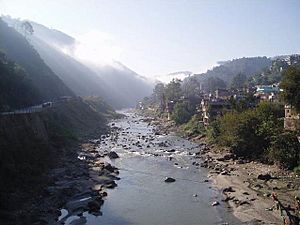
Mandi is built along the Beas River, where it meets the Suketi Khad stream. Some important hills and mountains near the city are Sikandar Dhar, Ghugar Dhar, and Dhar Kot. Mandi is located at 31°72'N latitude and 76°92'E longitude. Its average height is 764 meters (2,507 feet). It lies in the Midlands part of the Himalayan mountain range.
The climate in Himachal changes a lot because of the different heights. It can be hot and humid in the southern parts. In the northern and eastern mountains, it's cold, alpine, and has glaciers.
Geology of Mandi
Mandi is like a bowl-shaped flat area on the banks of the Beas River. It is surrounded by the high hills of Gandharv Hills, Motipur Dhar, Rehra Dhar, and Tarna Hill. Two small rivers, Suketi Khad and Skodhi Khad, flow into the Beas. Besides the flat land by the river, the area is steep and hilly.
Geologically, Mandi is in seismic Zone No. IV. This means it is near a fault line and can experience earthquakes. Several national highways pass through the city. These include National Highway-20 (Pathankot-Mandi), National Highway-21 (Chandigarh-Mandi-Manali), and National Highway-70 (Hoshiarpur-Sarkaghat-Mandi). State Highway-32 (Hoshiarpur-Mandi) also passes through. This means Mandi is well connected to many other towns and cities. Even though Mandi is an old city, it is developing fast. It still keeps its original charm and character.
Mandi's Climate
Mandi city is in the lowest climate zone of the Himalayas. It has a humid subtropical climate (Köppen Cwa). This means it has hot summers and pleasant winters with cold mornings. These areas have a wet, warm temperate climate in the foothills. This is different from the dry, cold alpine climate with snowfall at higher altitudes.
Temperatures usually range from 6.7°C (44.1°F) to 39.6°C (103.3°F) during the year. The average summer temperature is between 18.9°C (66.0°F) and 39.6°C (103.3°F). In winter, it's between 6.7°C (44.1°F) and 26.2°C (79.2°F). Rainfall changes from 15 millimeters (0.59 inches) in November to 515 millimeters (20.3 inches) in July. The average total yearly rainfall is 1685 millimeters (66.3 inches).
| Climate data for Mandi, Himachal Pradesh (1961–1990, rainfall 1951–2000) | |||||||||||||
|---|---|---|---|---|---|---|---|---|---|---|---|---|---|
| Month | Jan | Feb | Mar | Apr | May | Jun | Jul | Aug | Sep | Oct | Nov | Dec | Year |
| Record high °C (°F) | 27.7 (81.9) |
31.3 (88.3) |
39.0 (102.2) |
39.5 (103.1) |
42.1 (107.8) |
42.7 (108.9) |
40.0 (104.0) |
36.7 (98.1) |
35.9 (96.6) |
33.6 (92.5) |
33.2 (91.8) |
30.2 (86.4) |
42.7 (108.9) |
| Mean daily maximum °C (°F) | 18.9 (66.0) |
21.0 (69.8) |
26.0 (78.8) |
30.9 (87.6) |
34.8 (94.6) |
35.7 (96.3) |
32.2 (90.0) |
31.3 (88.3) |
30.9 (87.6) |
29.3 (84.7) |
25.1 (77.2) |
20.4 (68.7) |
28.0 (82.4) |
| Mean daily minimum °C (°F) | 2.3 (36.1) |
3.9 (39.0) |
8.7 (47.7) |
13.6 (56.5) |
17.3 (63.1) |
19.5 (67.1) |
20.7 (69.3) |
20.1 (68.2) |
17.8 (64.0) |
11.9 (53.4) |
6.8 (44.2) |
2.8 (37.0) |
12.1 (53.8) |
| Record low °C (°F) | −2.7 (27.1) |
−2.0 (28.4) |
0.0 (32.0) |
4.3 (39.7) |
5.4 (41.7) |
8.5 (47.3) |
12.0 (53.6) |
11.4 (52.5) |
9.7 (49.5) |
4.3 (39.7) |
1.0 (33.8) |
−2.9 (26.8) |
−2.9 (26.8) |
| Average rainfall mm (inches) | 82.0 (3.23) |
66.0 (2.60) |
72.4 (2.85) |
33.8 (1.33) |
70.9 (2.79) |
164.3 (6.47) |
515.7 (20.30) |
445.8 (17.55) |
151.4 (5.96) |
33.3 (1.31) |
14.9 (0.59) |
35.1 (1.38) |
1,685.6 (66.36) |
| Average rainy days (≥ 2.5 mm) | 4.5 | 4.1 | 4.6 | 3.0 | 3.9 | 7.8 | 15.9 | 16.7 | 7.5 | 1.8 | 1.0 | 2.1 | 72.9 |
| Average relative humidity (%) (at 17:30 IST) | 58 | 54 | 45 | 44 | 44 | 49 | 68 | 74 | 65 | 60 | 60 | 72 | 57 |
| Source 1: India Meteorological Department | |||||||||||||
| Source 2: International Scholarly Research Network | |||||||||||||
Mandi's Economy
Mandi is one of the fastest growing towns in Himachal Pradesh. It is located where National Highway-20, 21, and 70 meet. This makes it a gateway to places like Kullu, Lahaul, Leh, and parts of Jammu & Kashmir. Since it's the district headquarters, the whole district relies on Mandi for trade, services, and government.
Most of the region's economy is based on farming. About 79% of the people depend on agriculture and related activities for their living. The Balh Valley is known for growing good quality wheat, paddy, and vegetables. They use modern irrigation systems there. Other parts of the district grow corn, maize, wheat, rice, and vegetables to feed the population. A milk processing plant is located 8 kilometers (5 miles) from Mandi at Chakkar.
People in Mandi also grow rice, pulses, millets, tea, sesame, groundnuts, sunflowers, and herbs. Over 9,000 farmers in the lower hills of Mandi District are involved in cocoon farming for Silk production. However, they face strong competition from China, which sells raw silk at lower prices.
Many hectares of land in Mandi are used for growing apples. Apples are usually planted in December each year. The area used for fruit farming in Mandi is about 15% of the total fruit-growing area in Himachal Pradesh. Mandi's raw silk is famous, and the salt mines at Drang and Guma are important to the economy. There are also large deposits of salt and limestone. Experts are looking into whether there are also magnesite, coal, and china-clay. Mandi also has fish markets where brown trout is very popular. Farmers in Mandi can get around Rs. 200 per kilogram for brown trout.
Getting Around Mandi
In Mandi, you can travel by auto-rickshaw, bus, or private cars. Tourist taxis are also available. The main taxi stand is near Seri Stage. Auto-rickshaws are the most common way to get around and are available almost all day and night.
The closest airport to Mandi is Bhuntar Airport, which is about 75 kilometers (47 miles) away. Mandi is connected to Pathankot by National Highway 20, which is about 220 kilometers (137 miles) long. It's also connected to Manali and Chandigarh by National Highway 21, which is 323 kilometers (201 miles) long.
Some hotels and resorts in Mandi include Munish Resorts, Visco Resorts, and Regent Palms Hotel. Other hotels are Raj Mahal, Amar Atithi, Ashoka Holiday Inn, Hotel Evening Plaza, Mandav Hotel (HPTDC), Surbhi Hotel, and Hotel Yamini. Most visitors come to Mandi from Delhi or Chandigarh.
From Delhi The distance between Delhi and Mandi is about 475 kilometers (295 miles). A bus trip takes about 12 hours. You can also take a train from Delhi to Kiratpur Sahib using the Delhi-Una Himachal express (4553). From Kiratpur, you can take a bus. All buses from Delhi and Chandigarh to Mandi pass through Kiratpur. You can also drive using NH 1 to Ambala, then NH 22 to Chandigarh, and finally NH 21 to Mandi.
From Chandigarh There are buses from Chandigarh to Mandi and Manali. Some buses from Delhi pass through Chandigarh, and some start directly from Chandigarh. The distance between Chandigarh and Mandi is 200 kilometers (124 miles). A bus trip takes about 6 hours, and a taxi ride takes around 5 hours.
By Air The nearest airport is Kullu Airport at Bhuntar, about 75 kilometers (47 miles) from Mandi city. This is a small airport, and only small planes fly there. Flights to Kullu are only from Delhi and Shimla. A flight from Delhi to Kullu takes about 90 minutes.
By Rail Currently, there is no railway line to Mandi, but one is planned. There's a proposal to extend the Kangra Valley Railway to Mandi and connect it to a new Bhanupli–Leh line. The closest railway station right now is Jogindernagar Railway Station, about 50 kilometers (31 miles) from the city. This is the end point of the Kangra Valley Railway.
People of Mandi
In 2001, Mandi city had a population of 26,858 people. Males made up 53% of the population, and females 47%. Mandi has a high literacy rate of 83.5%, which is higher than the national average. Male literacy is 92%, and female literacy is 75%. About 11% of the population in Mandi is under 6 years old. In 2011, Mandi had a very good sex ratio – 1013 girls for every 1000 boys. Mandi has a mix of people from different religions, including Hindus, Muslims, Sikhs, Buddhists, and Christians. More than 90% of the population is Hindu. According to the 2011 census, the city's population was 26,422.
Mandi's Culture
Mandi is known as the cultural capital of Himachal Pradesh. People from Mandi are often called Mandyalis. The Mandeali language is commonly used for talking locally. Sepu Wadi is the main and official food of Mandi. A traditional lunch called Dham is usually served at local weddings and parties.
The Himachal Darshan Photo Gallery is about 4 kilometers (2.5 miles) from Mandi, near Sauli Khad, on the Chandigarh-Manali National Highway. This art gallery has many photos of beautiful places in the state. It also shows the social and cultural traditions of the people of Himachal Pradesh. The District Library is located in Emerson House (District Court).
In the past, boys in Mandi wore Kurta-Pyjama, and girls wore Sari-Suits. But now, with Western culture, many young people in Mandi wear Western styles. However, many people still wear traditional Himachal Pradesh clothing. Banthra is the main folk dance performed in shows in Mandi. It is the official folk dance of the District.
The Mandi Shivaratri Fair is a big international fair held in Mandi for seven days every year in February or March. The Shivratri celebration in Mandi is said to have started in 1526. This was to celebrate the founding of the current Mandi city. Before this, the capital was on the right bank of the Beas River, now called Old Mandi (Purani Mandi). Mandi also hosts a half marathon every year.
Long ago, when the tenth Sikh Guru, Guru Gobind Singh, visited Mandi, the king invited him to stay at the royal palace. The Guru accepted the invitation to stay in Mandi but chose a quiet place outside the town. This place was once the home of a sage. The Guru was touched by the king's devotion. He said that Mandi would always be safe. He believed that if any enemy tried to harm it, divine power would protect the city. He considered Mandi one of the safest places on Earth.
Learning in Mandi
Mandi has many schools, from early childhood centers (anganwadis) to primary and high schools. Some schools in the city include DAV Centenary Public School, Kendriya Vidyalaya, Mandi Public School, Indus Global School, The Phoenix School of Integrated Learning, Vijay Government Senior Secondary School, Government Senior Secondary School (Girls), Sarswati Vidya Mandir nagwain, Sai Public School, St. Xavier Residential School, DAV Sr. Secondary School, and Anglo Sanskrit Model School.
For higher education, Mandi has medical institutes like Himachal Dental College and Shri Lal Bahadur Shastri Government Medical College. Engineering colleges include Jawaharlal Nehru Government Engineering College, T. R. Abhilashi Memorial Institute of Engineering and Technology, and Vallabh Bhai Government College. The Indian Institute of Technology Mandi is an important university in the state. It offers many courses for Bachelor's and Master's degrees in engineering.
Media in Mandi
Mandi has many newspapers, television, and radio stations. Top Hindi newspapers include Amar Ujala, Punjab Kesari, Dainik Bhaskar, Dainik Jagran, Devbhumi Mirror, Divya Himachal, Himachal Dastak, Jansatta, Dainik Sawera, and Uttam Hindu. Magazines like Outlook and Champak are also available. English newspapers sold in Mandi include the Times of India, The Hindu, Hindustan Times, Indian Express, and The Tribune.
You can watch many Indian and international television channels in Mandi through local cable TV providers. The national TV broadcaster, Doordarshan, offers channels like DD Shimla, DD National, and DD Sports. Cable channels include news channels (Aaj Tak, Zee News, NDTV 24X7), sports channels (Ten Sports, ESPN), and entertainment channels (Colors, Sony, Zee TV, STAR Plus). Other local news channels are Pole Star Himachal and S-TV. Satellite television (DTH) is not very common. Some DTH services are Dish TV, TATA Sky, and Videocon TV. Mandi also has two radio stations. People generally use CRT, LCD, and LED televisions.
Sports and Adventure in Mandi
Mandi is home to the Bandy Federation of India. This organization is a member of the Federation of International Bandy, which is recognized by the IOC. The Bandy Federation of India is based in Mandi and manages the sport of Bandy in India. India is one of 7 countries in Asia and 29 countries worldwide that are members of the Federation of International Bandy.
Cricket and football are very popular sports in the city. The Shaheed Krishan Chand Memorial Stadium in Mandi hosts List A cricket matches. It is also known as Paddal ground and has held All India Ranji Matches. There are badminton courts in the Town Hall and at Paddal. An open swimming pool is located near Bhiuli. The city also has many snooker pools and table tennis halls. Rishi Dhawan is a cricketer from Mandi who plays for Kings XI Punjab in the Indian Premier League.
Adventure tourism has become popular in Mandi recently. This is because of its thick forests, beautiful hills, and the flowing waters of the Beas River. Mandi is a great place for all kinds of adventure sports. One such place is Sunder Nagar, a small town at the edge of the valley. It is over a thousand meters high and has some of the tallest trees in the state. The climate is colder, and the dense trees make it perfect for adventure lovers to go on nature trails. You can see many bird species, and walking through the thick forest and rappelling down rocky cliffs is very exciting.
Janjehli, about two hours from Mandi, offers treks up to 3000 meters (9,843 feet). Since the whole road isn't paved, the last part of the journey must be walked through a thick forest. Another trek from Janjheli goes through these forests to the Shikari Devi temple. This temple, dedicated to the goddess, is said to have been built during the time of the Pandavas and has no roof.
The Himalayan Trout House is about five hours from Mandi, in the Tirthan valley. You can find good trout fishing here in the river. Brown trout is a very popular fish species. In Mandi, a farmer can get around Rs. 200 per kilogram for catching brown trout. The hydroelectric power station at Jogindernagar can be reached by a trolley that goes up a rocky cliff to a height of about 2500 meters (8,202 feet). The trolley then goes down to Barot, where the reservoir is located.
Places to Worship
Temples Mandi has over 300 old and new temples. Because of so many temples and its location along the Beas River, Mandi is also called 'Chhoti (Small) Kashi'. Most temples are dedicated to Lord Shiva and the Goddess Kali. Many old temples are protected by the Archaeological Survey of India because they are historically important. The main ones are:
- The 'Panchvaktra Temple', located where the Beas River and Suketi Khad meet.
- 'Ardhnareshwar Temple', which is one of the few temples of its kind in India.
- 'Triloknath Temple', located on the right bank of the Beas River.
- The Mata Kuan Rani Temple, which has a slate-roofed temple over a deep well. It is dedicated to the 'Princess of the Well'. Legend says that Mandarava, the Princess of Sahor (Mandi), became a partner of Padmasambhava. The king was angry and sentenced them both to die in a fire that burned for seven days. After the smoke cleared, there was a lake with a lotus in it, now called 'Rewalsar' or Tso Pema (Tibetan: 'Lotus Lake').
Gurudwara Mandi has a historic Gurudwara (Sikh temple) dedicated to Guru Gobind Singh, the 10th Sikh Guru. He spent some time in Mandi. The people and the ruler welcomed him warmly and supported him in his fight against the Mughal Emperor Aurangzeb. It is said that the city has the Guru's blessings. The Gurudwara is also unofficially called Gurudwara Palang Sahab, because the Guru's Bed 'Palang' is still kept there.
Mosques There are two mosques in Mandi city: one on Jail Road and another in Ramnagar (Mangwayi). There is also a mosque (Madina Mosque) near IIT Mandi North campus in Salgi village in Khanahr, 16 kilometers (10 miles) from the main Mandi City.
Wildlife Sanctuaries
- Nargu Wildlife Sanctuary
- Shikari Devi Wildlife Sanctuary: This wildlife sanctuary covers an area of 29.94 square kilometers (11.56 square miles).
- Bandli Wildlife Sanctuary: Located in Mandi district, Bandli Wildlife Sanctuary covers an area of 41.32 square kilometers (15.95 square miles). It is at heights from about 600 meters (1,969 feet) to over 2000 meters (6,562 feet). It is about eight kilometers (5 miles) from Sundar Nagar. Its plants include Dry Mixed Deciduous Forests, Himalayan Subtropical Chir Pine Forest, and Himalayan Temperate Forest. Bandli Wildlife Sanctuary is home to many animals. These include leopards, barking deer, gorals, jackals, Indian foxes, Hanuman langurs, black bears, Indian porcupines, and Himalayan palm civets. Seventy (70) bird species have been recorded here. The Cheer pheasant, which is on the red list of the International Union for Conservation of Nature (IUCN), is also found here.
Famous People from Mandi
- Kangana Ranaut, a Bollywood actress.
- Sukhvinder Singh Sukhu, the current Chief Minister (from Congress party) of Himachal Pradesh.
- Pratibha Singh, the current President of the state Indian National Congress Committee.
- Rishi Dhawan, an all-rounder cricketer from Mandi district.
- Yami Gautam, a Bollywood actress.
Images for kids
See also
 In Spanish: Mandi (Mandi) para niños
In Spanish: Mandi (Mandi) para niños


